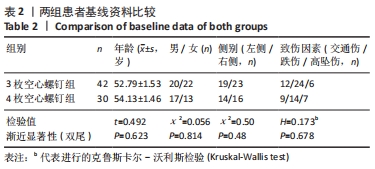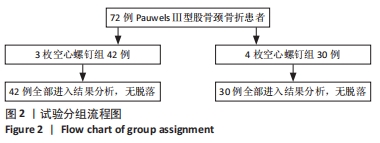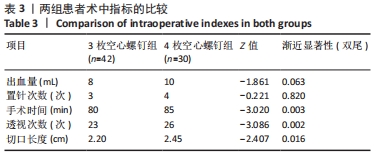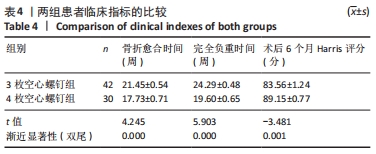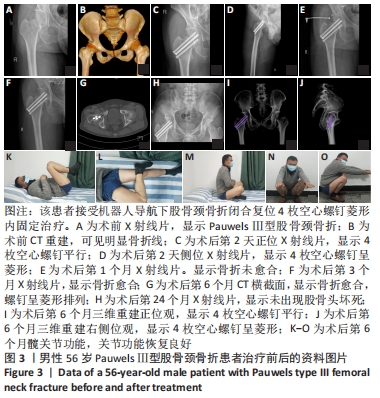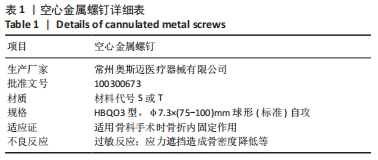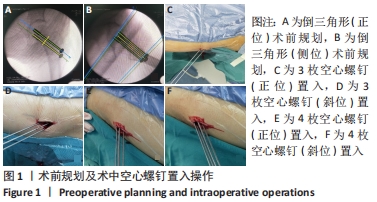中国组织工程研究 ›› 2022, Vol. 26 ›› Issue (15): 2352-2355.doi: 10.12307/2022.589
• 骨科植入物 orthopedic implant • 上一篇 下一篇
机器人导航下3枚与4枚空心螺钉内固定治疗Pauwels Ⅲ型股骨颈骨折
王佳琦1,罗晓中1,2,童 祎2,石维祥2,丁 勇2,周 欣2,吴 刚2
- 1西南医科大学附属医院骨与关节外科, 四川省泸州市 646000;2自贡市第四人民医院关节与创伤外科,四川省自贡市 643000
Pauwels type III femoral neck fracture treated with three and four cannulated screws assisted by robot navigation
Wang Jiaqi1, Luo Xiaozhong1, 2, Tong Yi2, Shi Weixiang2, Ding Yong2, Zhou Xin2, Wu Gang2
- 1Department of Bone and Joint Surgery, Affiliated Hospital of Southwest Medical University, Luzhou 646000, Sichuan Province, China; 2Department of Bone Joint and Trauma Surgery, Zigong Fourth People’s Hospital, Zigong 643000, Sichuan Province, China
摘要:
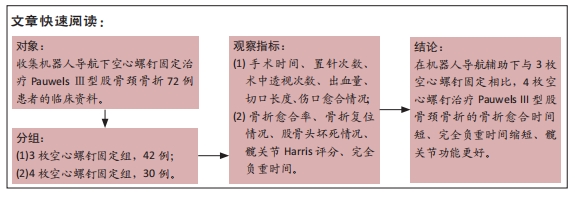
文题释义:
Pauwels分型:是依据骨折线与水平线之间的夹角角度大小对股骨颈骨折进行分型的一种分型方式,角度越小股骨颈垂直承重能力越强,反之,股骨颈承重能力越差;其中,Ⅰ 型, 0° <夹角角度< 30 °;Ⅱ型,30° <夹角角度< 50°;Ⅲ型,50° <夹角角度< 90°。
剪切力:“剪切”是在一对相距很近、大小相同、指向相反的横向外力(即垂直于作用面的力)作用下,材料的横截面沿该外力作用方向发生的相对错动变形现象,能够使材料产生剪切变形的力称为剪力或剪切力。发生剪切变形的截面称为剪切面。判断是否“剪切”的关键是材料的横截面是否发生相对错动。
背景:目前3枚空心螺钉倒三角构型固定不能为Pauwels Ⅲ型股骨颈骨折提供足够的稳定,有研究认为4枚空心螺钉较3枚空心螺钉能提供更好的稳定性,但是股骨颈空间有限,螺钉置入极容易失败,而机器人导航技术可有效解决这一问题。
目的:对比机器人导航下3枚与4枚空心螺钉内固定治疗Pauwels Ⅲ型股骨颈骨折的临床疗效。
方法:收集自贡市第四人民医院2013年7月至2020年5月机器人导航下空心螺钉内固定治疗Pauwels Ⅲ型股骨颈骨折72例患者的临床资料,其中男37例,女45例,年龄16-66岁,采用3枚空心螺钉内固定治疗42例,4枚空心螺钉内固定治疗30例。记录两组患者手术时间、置针次数、术中透视次数、出血量、切口长度、切口愈合情况、骨折愈合率、骨折复位情况、股骨头坏死情况、髋关节Harris评分及完全负重时间。
结果与结论:①72例患者术后均获随访,切口均Ⅰ期愈合,无切口感染病例,骨折愈合率均为100%,其中3枚空心螺钉组3例出现股骨头坏死,4枚空心螺钉组未出现股骨头坏死,随访过程中未发生空心螺钉引起的不良反应;②两组患者置针次数、出血量、骨折复位满意度比较差异均无显著性意义(P > 0.05),4枚空心螺钉组手术时间、切口长度及术中透视次数多均多于3枚空心螺钉组(P < 0.05),骨折愈合时间、完全负重时间短于3枚空心螺钉组(P < 0.05),术后6个月的髋关节Harris评分高于3枚空心螺钉组(P < 0.05);③结果表明,在机器人导航辅助下与3枚空心螺钉内固定治疗比较,4枚空心螺钉内固定治疗Pauwels Ⅲ型股骨颈骨折的骨折愈合时间短、完全负重时间缩短、髋关节功能更好。
https://orcid.org/0000-0003-4628-8196 (王佳琦)
中国组织工程研究杂志出版内容重点:人工关节;骨植入物;脊柱;骨折;内固定;数字化骨科;组织工程
中图分类号:
